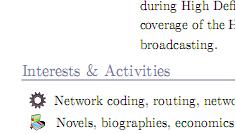Hello.
Sometimes it becomes necessary to include figures that were not generated in EPS. My first choice is to use powerpoint or impress to insert or create the picture in an empty slide, print to ps and then use ghostscript to set the bounding box correctly and make an eps file, or maybe even edit the bounding box manually in the eps header.
The problem I often face is that figures created in this manner are placed with the background in front of the document. Therefore I often see a white background from my figure blocking some text nearby. I can't edit the eps file to fix that (I'm not that savvy). Is there a better (and simple) way to convert images from other file types to eps? Is GIMP a better choice to do that? I try using it but get lost in between all of its functionalities. Maybe a tutorial on handling background?
Thanks
General ⇒ gif, tiff, png, jpeg conversion to EPS
 gif, tiff, png, jpeg conversion to EPS
gif, tiff, png, jpeg conversion to EPS
LaTeX itself handles the presentation of the document, allowing the writer to concentrate on the \textbf{conten...
!Runaway argument?
\par
<inserted text>
... concentrate on the \textbf{content}}
!Runaway argument?
\par
<inserted text>
... concentrate on the \textbf{content}}
NEW: TikZ book now 40% off at Amazon.com for a short time.

gif, tiff, png, jpeg conversion to EPS
Hello,
which is the source format of the pictures? In your subject, you say something about "gif, tiff, png, jpeg"—these could be converted without PowerPoint or Impress. Is there a special reason why you want to use PowerPoint or Impress? If not, try ImageMagick's convert program. Or use pdfLaTeX, which can include JPEG and PNG images directly.
which is the source format of the pictures? In your subject, you say something about "gif, tiff, png, jpeg"—these could be converted without PowerPoint or Impress. Is there a special reason why you want to use PowerPoint or Impress? If not, try ImageMagick's convert program. Or use pdfLaTeX, which can include JPEG and PNG images directly.
Re: gif, tiff, png, jpeg conversion to EPS
In this particular case it is a gif image. I want to keep using eps because it is a predefined template I'm using that requires the files to be eps. I was using impress/powerpoint because it's what I have at hand and it's a fairly simple process (and I have learned it that way) although not effective sometimes. I'll try imagemagick, see if it's practical.
Thanks
Thanks
LaTeX itself handles the presentation of the document, allowing the writer to concentrate on the \textbf{conten...
!Runaway argument?
\par
<inserted text>
... concentrate on the \textbf{content}}
!Runaway argument?
\par
<inserted text>
... concentrate on the \textbf{content}}
- localghost
- Site Moderator
- Posts: 9202
- Joined: Fri Feb 02, 2007 12:06 pm
gif, tiff, png, jpeg conversion to EPS
I wonder what this prerequisites could be that all graphics file have to be in EPS. Perhaps you can describe that a little bit. If this template doesn't use packages like PSTricks, which rely directly on postscript code, it is not necessary to compile exclusively with latex. Compilation then also can be done with pdflatex and images in PNG or JPG format can be kept in their original format..maurolust wrote:[...] I want to keep using eps because it is a predefined template I'm using that requires the files to be eps. [...]
Best regards and welcome to the board
Thorsten¹
How to make a "Minimal Example"
Board Rules
Avoidable Mistakes
¹ System: TeX Live 2025 (vanilla), TeXworks 0.6.10
Board Rules
Avoidable Mistakes
¹ System: TeX Live 2025 (vanilla), TeXworks 0.6.10
gif, tiff, png, jpeg conversion to EPS
You can use one vector graphics editor, My best choice is http://www.inkscape.org/maurolust wrote:My first choice is to use powerpoint or impress to insert or create the picture in an empty slide, print to ps and then use ghostscript to set the bounding box correctly and make an eps file, or maybe even edit the bounding box manually in the eps header.
gif, tiff, png, jpeg conversion to EPS
Well, I think I solved the problem with imagemagick convert program.
Now, the reason for it was the CV template I was using. I have tried to use jpeg other times, and failed. So instead of trying to make it work with other formats I decided to keep it "simple" by always using eps.

those icons are added by this command
like this
And I wanted to create my own icons.
Maybe it is a good idea to check how to use other formats.
cv template kindly offered by http://n.favrefelix.free.fr/site/
Now, the reason for it was the CV template I was using. I have tried to use jpeg other times, and failed. So instead of trying to make it work with other formats I decided to keep it "simple" by always using eps.
those icons are added by this command
Code: Select all
Code, edit and compile here:
\newcommand{\interest}[2]{\includegraphics[height=12pt]{#1}~\raisebox{1mm}{#2}}
Code: Select all
Code, edit and compile here:
\begin{interestsblock}{Interests \& Activities}\interest{gear}{Network coding, routing, network security, satellite communications}\\\interest{book}{Novels, biographies, economics, property rights, science, technology and history} &\interest{itf_cropped}{Taekwon-Do}\end{interestsblock}
Maybe it is a good idea to check how to use other formats.
cv template kindly offered by http://n.favrefelix.free.fr/site/
LaTeX itself handles the presentation of the document, allowing the writer to concentrate on the \textbf{conten...
!Runaway argument?
\par
<inserted text>
... concentrate on the \textbf{content}}
!Runaway argument?
\par
<inserted text>
... concentrate on the \textbf{content}}